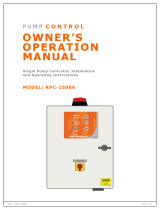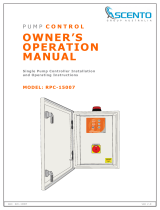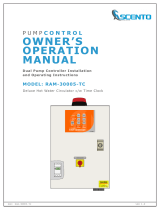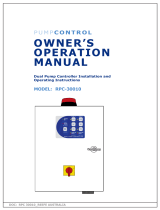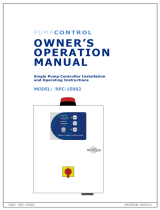Page is loading ...

SINGLE PUMP CONTROL
SPECIFICATION’S
AND OPERATOR
MANUAL
DOC: RPC-37001 VER 1.0
PUMP C O N T R O L

2
Note: Controller must be earthed and all electrical connections must be carried out by a suitably qualied
Electrician. For Single Working Level Float Switch Applications, connect to “Start (Input 3)” terminals only, and NO
bridge wire is required in “Stop (Input 2)” terminals.
FRONT SIDE VIEW
Top
Bottom
Top
Bottom
IN
1
IN
2
IN
3
IN
4
IN
5
SIREN
STROBE
FAULT
DOC: FPC 37001 VER1.0
INDICATOR LIGHTS GUIDE
3 FLOAT SWITCH SYSTEM
2 FLOAT SWITCH SYSTEM
WARNING: HIGH VOLTAGE
ALL ELECTRICAL CONNECTIONS MUST BE CARRIED OUT BY A SUITABLY QUALIFIED ELECTRICIAN
ACCESS BY AUTHORISED PERSONNEL ONLY
4 FLOAT SWITCH SYSTEM
PUMP 1
NO FLOAT SWITCH
CONNECTED TO INPUT 2
NO FLOAT SWITCH
CONNECTED TO INPUT 1
STOP
START
LEVEL
COMMON
N/O CLOSE ON RISE
HIGH
LEVEL
COMMON
N/O CLOSE ON RISE
BLUE NOT REQUIRED
BLUE NOT REQUIRED
NO FLOAT SWITCH
CONNECTED TO INPUT 1
STOP
LEVEL
COMMON
N/O CLOSE ON RISE
HIGH
LEVEL
START
LEVEL
COMMON
N/O CLOSE ON RISE
COMMON
N/O CLOSE ON RISE
BLUE NOT REQUIRED
BLUE NOT REQUIRED
BLUE NOT REQUIRED
STOP
LEVEL
LOW
LEVEL
ALARM
COMMON
N/O CLOSE ON RISE
COMMON
N/O CLOSE ON RISE
HIGH
LEVEL
START
LEVEL
COMMON
N/O CLOSE ON RISE
COMMON
N/O CLOSE ON RISE
BLUE NOT REQUIRED
BLUE NOT REQUIRED
BLUE NOT REQUIRED
BLUE NOT REQUIRED
240Vac
MAINS POWER
SUPPLY
MAIN
ISOLATOR
SwLi SwLo
A NA N A N
IN P1 P2
EXTERNAL
MUTE
VOLT FREE
FAULT CONTACT
VOLT FREE
FAULT CONTACT
VOLT FREE
FAULT CONTACT
MAIN
ISOLATOR
MAIN
ISOLATOR
IN
1
IN
2
IN
3
IN
4
IN
5
SIREN
STROBE
FAULT
PUMP 1
240Vac
MAINS POWER
SUPPLY
SwLi SwLo
A NA N A N
IN P1 P2
EXTERNAL
MUTE
IN
1
IN
2
IN
3
IN
4
IN
5
SIREN
STROBE
FAULT
PUMP 1
240Vac
MAINS POWER
SUPPLY
SwLi SwLo
A NA N A N
IN P1 P2
EXTERNAL
MUTE
E
A
R
T
H
DIP SWITCH
2 ON TO
ENABLE
LOW LEVEL
PUMP CONTROL
ON
E
A
R
T
H
E
A
R
T
H
E
A
R
T
H
E
A
R
T
H
E
A
R
T
H
ON STEADY
A pump fault/overload has occured
FLASHING
A prime loss fault has occured
MOMENTARY PRESS
To mute audible buzzer
PRESS FOR 3 SECS
To reset alarms and faults
PRESS CONTINUOUS
To test indicator lights,
strobe and siren
ON STEADY
Pump is switched on to run
ON STEADY
A high level alarm has been present for the preset time
FLASHING
A low level alarm is present
MUTE/
RESET
PUMP ON
LEVEL ALARM
FAULT
Mounting
Frame/
Wall
INSTALLATION
CONNECTION
MOUNTING
MAIN ISOLATOR
1. Controller enclosure must be
mounted in a vertical position.
2. Ensure mounting method does
not compromise enclosure
weather proof rating.
3. Ensure access to main isolator is
not restricted.
4. Ensure cables/conduits entering
the panel have mechanical
protection and that the
penetrations are sealed and do
not compromise the weather
proof rating of the enclosure.

3
The COMPAKT single pump controller is as the name indicates, it is compact. It has all the features of the APC6
Single Pump Controller and is suited to most applications. The COMPAKT is an off the shelf ready to go product in two
ranges, 0.1-6amp and 5-16amp. Being compact there is no capacity to add additional features such as a HMI, specic
BMS, telemetry or additional pumps. This is the exibility of the APC6 Single Pump Controller.
The following features are included in the COMPAKT control:
- 5x Digital inputs arranged as screw terminals.
- 2x 230Vac Pump outputs. Using a heavy duty relay capable of switching pumps up to 1.5kW.
- Current monitoring of pumps for detection of overload and subsequent shutoff.
- 2x 12Vdc outputs for siren and strobe. Protected from overload by a current sensing circuit.
- 1x Voltage free normally open ‘common fault’ output (rated to 24VDC, 1A).
- 1x Single Pump Keypad Interface
- 1x External mute button input (IN5 input screw terminals).
- DIP switches to select:
• Operation mode
• Alternation time
• Anti-seize protection
• 5 minute manual timeout
• High level options
FEATURES

4
The controller is supplied from single-phase, 230Vac mains with a tolerance of ±10%. Maximum power draw of the
controller itself is 10W.
Inputs
The device has 5 inputs, each which presents a 1.2kΩ impedance from a 12V nominal source. The controller samples
the inputs at 100Hz and then lters them to the 10Hz main operating speed. Note that the inputs are not optically
isolated and therefore care must be taken if connecting these to anything other than voltage free contacts (such as
oat switches or relays).(nominal) only.
Input Specication
Input 1
12VDC(nominal)supply into 1.2kΩ input impedance. Not optically isolated. Sampled at 100Hz.
Input 2
Input 3
Input 4
Input 5
Strobe output 12VDC Nominal. Combined maximum current draw of 300mA. Electronically protected from overloading.
Siren output
Fault output Normally open, voltage free contacts. 1A, 24VDC maximum. Contacts close on fault.
Pump 1 output 240VAC, single phase. Maximum pump size is 1.5kwand/or 16 Full Load Amps. Full electronic overload protect on.
Pump 1 output
POWER
The following is an overview of all signals and connections to the device. The extra low voltage terminals are
completely isolated from the mains supply using a step-down transformer. The ELV section of the controller operates
on 5V and 12V
CONNECTIONS
Siren and Strobe
The siren and strobe outputs are designed to directly drive audible and visual indicators up to 3W in power. It supplies
a nominal 12VDC to the indicator and can supply a maximum combined current of 0.3A to the pair of outputs.
The device will limit the maximum current draw to a peak of approximately 1.5A, but in the event of a sustained
overload on either of these outputs (combined current draw exceeds 300mA for 500 milliseconds), the device will
detect the problem and shut off both outputs. It will then reattempt to resume normal operation of these outputs every
2 minutes (in case the fault has cleared).
Fault Output
In addition to the siren and strobe indicator outputs, the unit also provides a universal fault indication output for
connection to BMS or other systems. This output is a set of voltage free relay contacts with a capacity of up to 1A and
24VDC.
Pump Outputs
In addition to the siren and strobe indicator outputs, the unit also provides a universal fault indication output for
connection to BMS or other systems. This output is a set of voltage free relay contacts with a capacity of up to 1A and
24VDC.
CONNECTION OVERVIEW

5
DIP Switch Settings
In order for easy operator conguration, 6 DIP switches allow for selecting the most common conguration options as
per the following table:
The COMPAKT PCB is 100% compatible with all existing Matelec Dual and Single pump APC range keypads. This
provides operator control and feedback via seven buttons and ten LEDs:
- Auto/off/manual buttons for each pump
- Mute button
- Power LED
- Level alarm LED (steady for high level, ash for low level)
- Auto/man/active/fault LEDs for each pump
The buttons are arranged in a matrix conguration and are scanned by the controller at a relatively low rate of 100Hz
and the matrix input channels include robust electrical ltering. This is designed to minimise the effect of any noise
coupled onto the relatively long keypad tail in industrial environments.
KEYPAD
The COMPAKT PCB supports most of the operational functionality of the APC6. This includes many advanced
features in addition to the basic dual pump operation.
The most common conguration options are selected using a 6-way DIP switch located on the controller.
OPERATIONS
DIP SW Function Position Description
1/2 Operation
Mode
Off | Off A) Standard oat switch conguration (start, stop, high level).
Optional standby start.
Off | On B) Standard oat switch conguration with low level
(low level, start, stop, high level).
On| Off C) Standard oat switch conguration (start, stop, high level) with prime loss
On | On D) Pressure pumping conguration (Lead, Lag, Low Pressure)
3
Pump
Alternate
Options
Off Not used with single pump version
On Not used with single pump version
4Anti-seize
Function
Off Anti-seize timer disabled
On Anti-seize timer enabled
5
Pump
Manual
Timeout
Off When placed in manual mode pump remains in manual mode
On After manual_ timeout (5 minutes) in manual mode the pump will revert to auto
mode
6
High Level
Alarm
Options
Off High level alarm automatically resets upon lowering of high level oat.
High level alarm delay = alt_high_level_delay (15 minutes).
On High level alarm only resets by holding mute button for 2 seconds (latching).
High level alarm delay = high_level_delay (5 minutes).

6
Operation Mode A: Standard Conguration
Stop/Start/High level operation. When the pump start input is triggered the selected pump will be turned on.
The pump will remain on until both the pump start and pump stop inputs have turned off. Inputs functions are as per
the following table:
Input Function
Input 1 Not used
Input 2 Pump Stop
Input 3 Pump Start
Input 4 High Level
Input 5 External Mute
Operation Mode B: Standard conguration with low level
Stop/Start/High level operation, plus a low level input. The low level input must be active or pump start and pump stop
inputs are ignored. High level input will still override the low level and run both pumps. Input functions are as follows:
Input Function
Input 1 Low Level
Input 2 Pump Stop
Input 3 Pump Start
Input 4 High Level
Input 5 External Mute
There is some basic logic to determine, based on the input states, whether a low level or high level condition is to be
interpreted:
Low Level Pump Start High Level Pump State Alarm
On Off Off Off -
On On Off On -
On On On On High level (after timeout)
On Off On On High level (after timeout)
Off Off Off Off -
Off On Off Off Low level
Off Off On Off Low level
Off On On On High level (after timeout)
In addition to this logic there is the low level alarm. If there is a low level alarm then both pumps will be locked out
until the alarm is manually reset. This lockout will only be overridden upon a high level condition where both the pump
start oat and high level oats are closed.

7
Operation Mode C: Standard conguration with prime loss
Start/stop/high level operation, with input 1 connected to a prime loss pressure/ow sensor. If at any stage whilst a
pump is running the prime loss input turns off for prime_fault_delay (2 minutes) then a fault is immediately set for that
pump and duty alternates. Input functions are as follows:
Input Function
Input 1 Prime Switch
Input 2 Pump Stop
Input 3 Pump Start
Input 4 High Level
Input 5 External Mute
Conguration Mode D: Pressure pumping conguration
In pressure pumping the system attempts to maintain a constant pressure as best it can using on/off control of two
pumps. Input functions are as follows:
Input Function
Input 1 Prime loss ow switch
Input 2 Lead pump pressure switch (set at 400kPa)
Input 3 Lag pump pressure switch (set at 350kPa)
Input 4 Low pressure switch (set at 200kPa)
Input 5 External Mute
Operation to maintain a minimum pressure is as follows. There is a slight difference in terminology compared with the
other operation modes:
Duty Pump: Lead Pump
Additionally, note that the pressure switches close on low pressure and open on high pressure.
1. If the lead pump pressure switch closes for pressure_start_delay, then the lead pump will be switched on.
The lead pump alternates each time this occurs.
2. When the lead pump pressure switch opens again the lead pump will turn off. If this occurs before the
pump has been running for pressure_min_run seconds then the pump will not turn off until this period has elapsed.
3. If both the low pressure and (lead start and/or lag start) inputs activate then the pump will be switched
on immediately. If this condition exists for pressure_alarm_delay then the pump will be shut down and a low
pressure alarm will be signaled. The pumps will remain locked out until the low pressure fault is reset.
4. If pump are started due to low pressure and then the pressure is restored the pump will continue to run until the
lead pressure switch deactivates.
The prime loss input functions the same as in mode C, with input 1 connected to a prime loss pressure/ow sensor. If
at any stage whilst a pump is running the prime loss input turns off for prime_fault_delay (2 minutes) then a fault is
immediately set for that pump and duty alternates.
In pressure pump mode some of the other operational features will NOT operate:
- Anti-seize timer
- Maximum idle
- Maximum run fault

8
Condition Anti-seize will run
Pump mode = off No
Pump mode = manual No
Pump overload fault No
Pump prime fault No
Pump maximum run fault No
Anti-seize Timer
When enabled the anti-seize timer will automatically run a pump for antiseize_run_time (5 seconds) if a pump has
not been run for antiseize_period (7 days). This pump operation will completely override all inputs including the low
level (if enabled). This feature will only run if the pump is set in Auto, and alternates pump duty so that the alternate
pump is operated each time. A pump that has been locked out due to a fault will not run (although low level lockouts
are overridden).
The following table shows conditions in which the anti-seize run will not occur:
Manual Mode Timeout
If this option is enabled then a pump will only remain in manual mode for manual _timeout (5 minutes), after which it
automatically switches back to automatic mode.
High Level Alarm Reset
Leaving DIP switch 6 set to off will cause the high level alarm to automatically reset once the high level input turns off.
The controller will also use the alt_high_level_delay period (5 minutes) for the alarm activation delay.
Setting this switch to on will cause the high level alarm to latch until the unit is reset by holding down the mute button
for 2 seconds. The high level alarm will use high_level_delay period (15 minutes) for the alarm activation delay.
Maximum Idle Function
Sometimes it is desirable to keep levels in a tank as low as possible in order to prevent odour buildup, or maximise
overhead in the event of an inlet surge. To achieve this the controller features a maximum idle timer, which will trigger
a pump start condition if either pump has not run for max_idle_period (4 hours), and the stop input is closed. The pump
will continue to run until the stop input opens again.

9
Maximum Run Fault (upon request)
The maximum run fault operates both in auto and manual modes. If a pump runs continuously for the time specied
by the max_run_fault_delay parameter then a fault will be agged. That pump will be disabled until the fault is reset.
Setting max_run_fault_delay to zero will disable the maximum run fault feature.
External Mute
Input 5 is congured to be connected to an external mute button. The button will operate the same way as the mute
button on the keypad:
- Pressing once will mute the siren
- Pressing and holding for 2 seconds will reset the controller
- Pressing and holding for 3 seconds will perform a keypad LED test
ALARMS AND
FAULT INDICATION
The COMPAKT has a number of fault and alarm conditions that it can detect and report, as per the following table:
Fault LED State
Pump Overload Pump Fault LED on steady
Pump Prime Loss Pump Fault LED ashing slowly
Pump Max Run (If enabled) Pump Fault LED ashing fast
High Level Level Alarm LED on steady
Low Level Level Alarm LED ashing
Low Pressure Level Alarm LED ashing
Siren/Strobe output fault Power LED ashing
All faults are latching (with the exception of the high level fault if DIP switch 6 is set to off) and the siren/strobe output
fault. In order to reset the fault the mute button needs to be held down for 2 seconds. All faults are persistent, meaning
that they are saved and restored following power loss.
When any fault is active the fault outputs on the controller will also be activated. The fault output contacts will close
and the siren and strobe will activate.
Pressing the mute button at any time will cause the siren to mute. Alternatively if the unit isn’t muted it will continue to
sound for 5 minutes and then transition to “chirp” mode. In this mode the siren makes a short “chirp” once every 5
minutes. This minimises the noise pollution generated by the system. Pressing the mute button during chirp mode will
silence the system completely.
If a new alarm is triggered the existing mute state will be canceled and the alarm will begin to sound again.
The strobe and siren outputs are electronically protected for excessive current draw. If the combined current of both
outputs exceeds 300mA for 500 milliseconds then both outputs will be immediately switched off and an alarm fault
agged. In an alarm fault condition the power LED will ash slowly.
After 2 minutes the controller will clear the siren/strobe alarm fault. If the fault condition has been rectied then the
system will continue operating normally, otherwise the alarm fault will occur again. This cycle can repeat indenitely
while ever there is a problem with the siren or strobe.

10
ELECTRONIC OVERLOAD
SPECIFICATIONS
Trip Curves
Every 20 milliseconds the controller performs an overload calculation. This simulates the operation of a standard
bimetallic thermal overload and I^2 R heating effects. It will allow a startup current of up to 10 times the full load
current of the pump for 1 second before tripping. The trip curves can be viewed below.
The electronic overload functionality of the system is very precise and provides a reliable method of protecting each
pump from overload. Current draw of each pump is sampled with an effective 13-bits at 1.6kHz and the true-RMS
calculated in real time within the controller (using a 32-sample rolling buffer).
Note that at its maximum overload setting of 16A, the current sensing circuits can measure a maximum of 12x the full
load current and thus the minimum trip time is limited to approximately 2.5 seconds as shown in the above plot. In the
case of a lower overload setting (for example, 10A) the system can react proportionally to even higher multiples of the
full load current. A multiple of 50x FLA will cause the overload to occur within 30ms; the shortest reaction time possible.
Key times to trip are:
Multiple of Overload Setting Trip Time
1x Will not trip
1.05x 16 Minutes 16 Seconds
1.5x 1 Minute 20 Seconds
5x 3.84 Seconds
10x 1 Second
Cooldown
By nature of their construction, bimetallic strip based overloads have an automatic cool-down time after a trip event
before the overload can be reset. The electronic overload simulates a similar function.
When an overload condition results in the unit switching off the pump the unit will simulate the cool-down. It will take
approximately 100 seconds for the cool-down to complete and therefore it will not be possible to reset the overload
fault for that pump during that period.
Cycling power to the controller will immediately reset the cool-down timers and allow the pumps to be run again
immediately, however this is not a recommended technique. Most of the time there will have been a sufcient period of
time elapsed between the alarm triggering and a technician arriving on site that the cool-down timer will have elapsed
any way.
Multiple of Full Load Current
1
2
3
4
5
6
7
8
9
10
12
Trip time (seconds)
1
10
100
1000
0.1
Trip Curve

11
CIRCUIT DIAGRAM
ISOLATOR
SUPPLY A
SUPPLY B A N
PUMP 1
M
LOW LEVEL FAULT OUTPUT
(DRY CONTACTS)
SIREN
12VDC NOMINAL
LO
LI
A IN
A IN
P1 A
P1 N
P2 A
P2 N
INPUT 1
INPUT 2
INPUT 3
INPUT 4
INPUT 5
STROBE +
STROBE -
SIREN +
SIREN -
FAULT
-
+
-
+
PUMP STOP
PUMP START
HIGH LEVEL
STROBE
12VDC NOMINAL
EXTERNAL
MUTE BUTTON
E
NOTE: INPUT 1-5 CONFIGURATION AS PER OPERATION MODE ‘B’. FOR OTHER CONFIGURATIONS REFER TO
TO APPROPRIATE SECTIONS OF THE MANUAL.

12
AT A GLANCE
INDICATORS PUSH BUTTONS
DISTRIBUTED BY: INSTALLATION DATE:
SERIAL NUMBER:
KEYPAD
A quick reference to the
controller’s Keypad and
Indicator functions and
meanings.
POWER ON
Power is turned on.
LEVEL ALARM ON
A high level alarm has been
present for the preset time.
FLASHING
A low level alarm is present.
ON STEADY
Pump switched on to run.
ON STEADY
A pump fault/overload has
occurred.
FLASHING A prime loss
fault has occurred.
Silences the siren and if held
down for 3 seconds, clears all
faults
If selected (the LED indicator
will conrm if on) the particular
pump is set to Automatic
Pumping Mode
Turns pump off
If selected (the LED indicator
will conrm if on) the pump is
set to Manual Pumping Mode
POWER ON
LEVEL ALARM
PUMP ON
FAULT
AUTO
MAN
OFF
MUTE/
RESET
/

